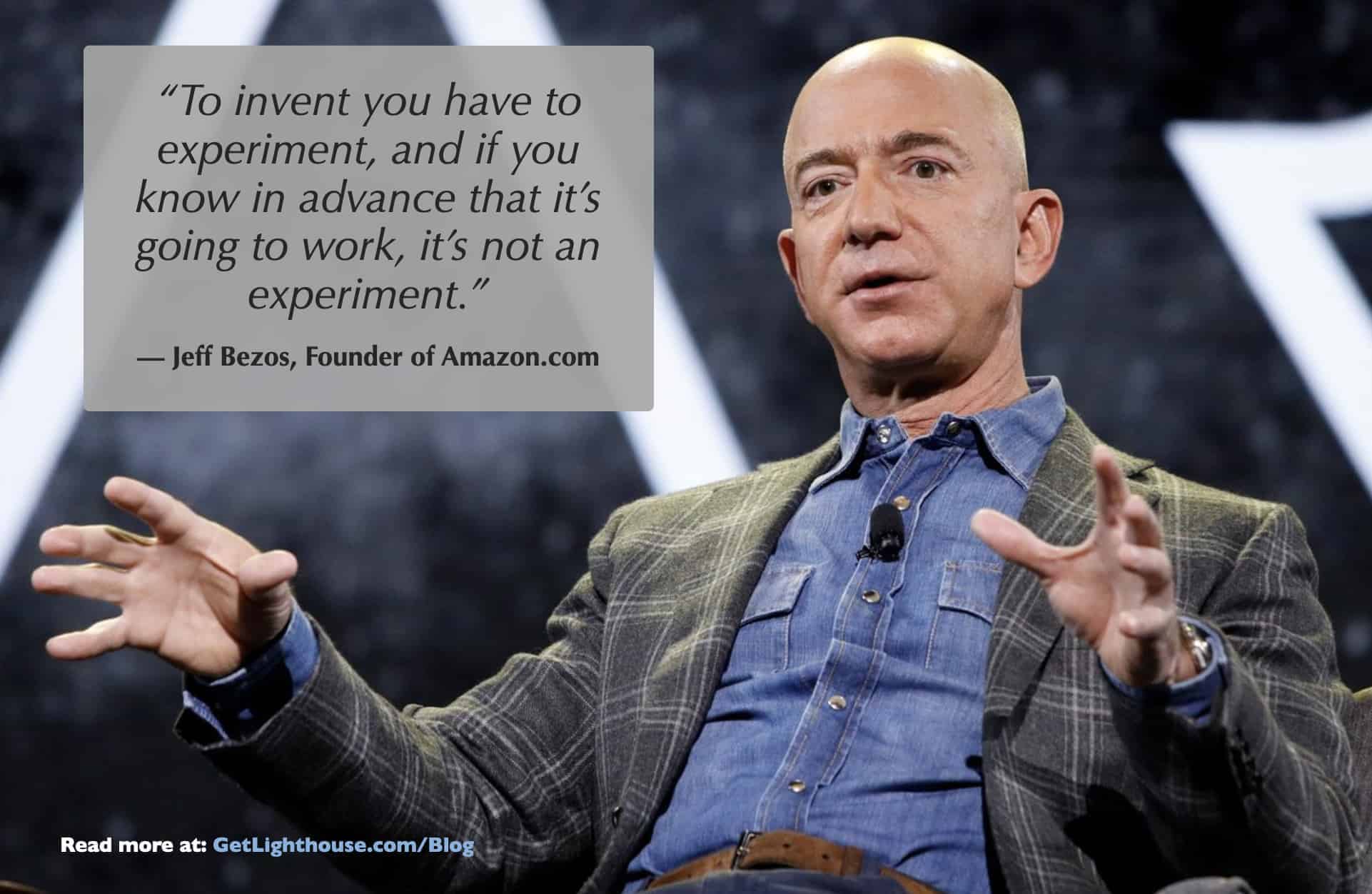What can you learn from one of the most influential people in (recent) history? Are there any lessons from Jeff Bezos' leadership style you can apply to your team today?
You may not know it, but Bezos made a short trip to space in 2021. He went on the first crewed flight of the New Shepard, the rocket ship made by his space company, Blue Origin. That happened 15 days after he stepped down from his role as CEO at Amazon, handing that role over to Andy Jassy, in order to focus on, "new products and early initiatives."
Jeff Bezos' achievements are incredibly impressive. They include building the world's highest-valued company from scratch and donating more than $2bn to charity. To accomplish those things, Bezos has used a few surprisingly straightforward leadership principles. In today's post, we'll be sharing some of the most important ones and providing advice on how you can use them to better lead your team.
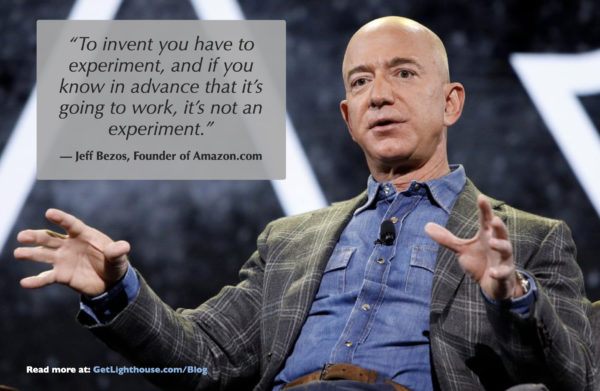
5 Jeff Bezos Leadership Principles You Can Apply to Your Team
We've compiled these principles from our favorite Bezos' quotes, books, public speeches, and appearances we found. Each quote contains a link to its original source, so you can learn more about that specific area you're interested in.
Let's dive into today's 5 principles and ways you can apply them at your company.
Table of Contents:
- Embrace failure to succeed more
- Use meeting memos to save time
- Keep innovating as you grow
- Use the two pizza rule for teams
- Make your most important decisions early in the day

1. Embrace failure
"One area where I think we are especially distinctive is failure. I believe we are the best place in the world to fail (we have plenty of practice!), and failure and invention are inseparable twins.
To invent you have to experiment, and if you know in advance that it's going to work, it's not an experiment.”
This quote from one of Jeff Bezos' Amazon shareholder letters shows why he values failing so much. For him, failure is a highly important tool for continually improving and learning new things.
Bezos explained that, despite this, there's a very important difference between good and bad failure.
In "Invent and Wander: The Collected Writings of Jeff Bezos”, he was quoted saying:
"If we build a new fulfillment center and it's a disaster, that's just bad execution. But when we are developing a new product or service or experimenting in some way, and it doesn't work, that's OK. That's great failure.”
For Bezos, the context of failure is key. You have to consider the outcomes of your mistakes to know where you can afford to fail.
We know this sounds abstract. However, we can show you exactly what he means and how to apply that principle to your team.
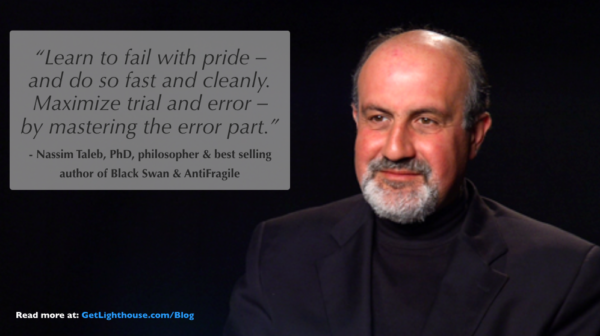
A balanced approach to failing: Task Relevant Maturity
According to EY, 79% of C-suite executives say their organizations accept failure and consider it a key element of innovation.
Despite that, knowing how to make failure a part of your culture is tricky. How can you ensure there's enough room for mistakes in your organization without putting everything at risk?
Use the waterline to turn risk and failure into your advantage.
The company W.L. Gore has created an awesome analogy for solving this. It's called "the waterline principle”:
"The waterline principle means that it's ok to make a decision that might punch a hole in the boat as long as the hole is above the waterline so that it won't potentially sink the ship.
But, if the decision might create a hole below the waterline which might cause the ship to sink, then associates are encouraged to consult with their team so that a collaborative decision can be made.”
W.L Gore encourages giving your team enough room to improve through failure, but ensuring they don't make mistakes with irreversible nor fatal consequences.
If it's a high-risk task, you should be more hands-on and provide guidance to your team. Meanwhile, if it is a low-risk project or task, give your people more freedom to experiment, innovate, and make mistakes.
Such a balanced approach to failing will contribute to a more open way of thinking at your company, aligning with Jeff Bezos's management style. It will also accelerate your people's growth by giving them more opportunities to learn from experience.
That's likely exactly what Jeff Bezos had in mind when he first started encouraging mistakes at Amazon.
We've written other posts about learning from mistakes. You can check them out here:
- The Most Important Aspect of Task Relevant Maturity Many Leaders Forget
- How Managers Can Cause Low Employee Morale
- Chaos Theory and Management: Learning from Systems in Nature
- 3 Essential Leadership Lessons Most Entrepreneurs Learn the Hard Way
2. Use meeting memos
Bezos was quoted saying banning PowerPoint slides in meetings at Amazon was "probably the smartest thing we ever did.”
What he introduced instead was the concept of the pre-written brief or memo.
At Amazon, every meeting starts with each attendee silently reading a "six-page, narratively-structured memo” before any discussion begins.
Bezos explained that these memos serve to create context for a productive discussion. While reading them, attendees are encouraged to take notes and discuss them after everyone is done reading.
Introducing memos contributed to Amazon accomplishing a few important things:
- It leveled the playing field for everyone by allowing people to understand the context of the meeting;
- It encouraged active participation, even among those who had very little time to prepare like executives;
- It made the goal of every meeting clear so no one felt like they were losing time by being in it;
- It encouraged the meeting organizers to put effort into preparation, as they would usually receive feedback on their memos.
Here is an example of some of those rules (originally posted by Amazon's @captaindanny10):
Not enough time for 6-page memos? Try meeting agendas
Preparing six-page memos for every meeting is a big ask. Besides, those memos are meant mainly for group meetings. There's a much simpler alternative you can use to make sure you're getting the most out of your 1:1s - creating a great one on one meeting agenda.
Having meeting agendas for every check-in is great for a couple of reasons. It ensures you're building momentum and continuity with everyone on your team, as well as encouraging their active participation. They know what to expect and so do you.
Creating agendas will help you make your 1:1s much more intentional.
Here's what you can do to get the most out of them:
- Make sure your team member adds their talking points to the agenda;
- Let them talk about their items first;
- Add your own 1:1 meeting questions and topics;
- Avoid status updates;
- Take management notes to remember action items and key details;
- Set a deadline for creating agendas to drive accountability.
Similar to Amazon's memos, agendas can make every meeting more productive. The 1:1 itself can remain fluid and open-ended, but having a bit of structure will ensure you and your team member understand the goal of each check-in and they stay motivated.
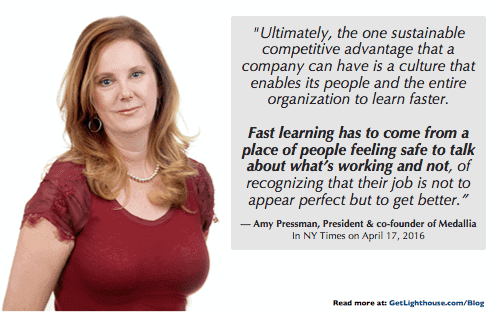
3. Keep innovating
"If you decide that you're going to do only the things you know are going to work, you're going to leave a lot of opportunities on the table."
"If you double the number of experiments you do per year you're going to double your inventiveness."
These two quotes by Bezos illustrate his passion for exploring new opportunities. According to the Drucker Institute, a leadership-focused think tank, Amazon was the most innovative company in the world in 2020.
The institute used 11 indicators to create an innovation coefficient and put Amazon ahead of Apple, Microsoft, Alphabet, and other competitors of similar stature.
They outpaced everyone else in the number of patent applications, trademark registrations, and R&D investments. The report also found that Amazon abandons patent applications at a higher rate than others, which ties back to our earlier point about embracing failure.
Bezos sees innovation as an integral part of his philosophy, and you can see it in their many product launches and new initiatives. From stumbling onto Amazon Web Services as a great business to the failed Amazon phone, they're not afraid to step outside what an online bookstore was supposed to be, reflecting Jeff Bezos's leadership style.
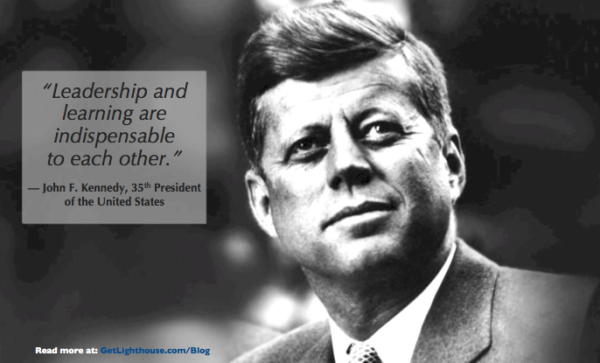
Never stop learning
We'll be honest - this principle was the most difficult one for us to turn into an actionable recommendation. Amazon has billions of dollars to innovate with. It's constantly patenting new things and raising the bar in a number of areas. What can you take away from that as a leader with a budget many times smaller?
Well, the idea of innovating should always be on your mind. How can you be more innovative and creative as a leader? Look for new sources of knowledge.
The Greek philosopher Plato once said: "I know that I know nothing.” What he meant by this was that his thirst for knowledge was eternal.
No matter what stage of your career you're in, you should always strive to improve by finding inspiration in unorthodox places.
If you don't know where to start, that's okay - we've got you covered. You can try choosing from:
- The 10 Best Books for New Managers on Leadership and Self-Improvement
- 5 Awesome & Unconventional Books for Leaders to Learn From
- 3 Books Every Manager Should Read
- Our article on the link between Chaos Theory and management
Make exposing yourself to new information a habit and embrace innovation as part of your leadership style. At the very least, this will prevent you from only having a handful of the same ideas all of the time.

4. Use the Two Pizza Team Rule
Have you noticed how much more difficult leading teams becomes as your team grows? Jeff Bezos has, which is why he has a unique take on team organization and communication.
Bezos figured out that individual teams shouldn't be larger than what two pizzas can feed. At Amazon, that meant limiting the number of people in one team to eight.
There's actually research to back up that principle. As an organizational psychologist and expert on team dynamics J. Richard Hackman pointed out, the number of links between people is the main culprit behind the inefficiency of large teams.
Let's dive into why this is the case. As the image above shows, every new person on your team creates more lines of communication than the last person added. With just 13 people on your team, you have to make a dizzying 78 lines of communication work somehow.
This presents an organizational nightmare for you as a manager. It can lead to:
- More tasks to delegate and outcomes to manage
- More communication issues to resolve
- Having more interests and motivations to consider than you can effectively handle
If you lead teams with 10+ people, you've already likely experienced some of these challenges. If you can't give everyone on your team the attention and coaching they need, it's time to make a change.
Implementing the two pizza team rule and creating smaller teams
Let's say you've decided to try Bezos' two-pizza team rule. You've figured out you can't keep track of a growing number of people, and now you're willing to create smaller teams. How can you do that?
You need to promote and develop new leaders. If that doesn't happen, your team can easily start feeling rudderless and resent you due to not getting enough attention. To prevent that, you need to help people within your team grow into leaders. Here's 3 things you can do:
1) Look for those who are already acting like leaders
Promote someone who has already shown initiative and independence. Reward patterns of behavior you want to see more of from other members of your team like empathy for others and a willingness to help.
Also be careful to make sure you're promoting based on merit, and not someone who kisses up to you or plays politics.
2) Learn how to delegate effectively
Use the concept we previously mentioned, Task Relevant Maturity, to determine when you can let your team work on their own, and when you need to be more hands-on.
If they're just starting out, or if their mistake can cause your proverbial ship to sink (i.e. lead to losing a customer or missing a major deadline), be more hands-on and guide them in their work.
Meanwhile, if they've shown you they can handle a task successfully, give them more independence. If they're really good at something, be prepared to let them take the lead and make suggestions on how to approach new projects.
3) Coach and develop your new leaders
Once you promote someone to be a manager and give them some of your direct reports, your work is just beginning. Be prepared to invest in their success by coaching and developing them. Use your 1:1s with them to share advice, strategies, and tools you've used to be a successful manager.
With these three best practices, you'll be more likely to successfully scale your team and organization as it grows.
Want more resources on growing leaders within your team? Check out some of the following links:
- Employee Coaching: Why it Matters and How to Become Great at It
- To be Great, Managers Must Become Coaches (Learn why & how)
- 12 Questions for Your Team to Become a Better Coach at Work
- Who do you promote? 5 Qualities of a Good Leader
- How to Become a Senior Leader in 5 Key Steps

5. Make high-quality decisions early in the day
"I go to bed early, I get up early...I also like to do my high-IQ meetings before lunch. Anything that's going to be really mentally challenging--that's a 10 o'clock meeting. Because by 5 p.m., I'm like, 'I can't think about that today. Let's try this again tomorrow at 10."
"If I make three good decisions a day, that's enough. They should just be as high quality as I can make them.”
The "before lunch" and "high-quality decisions” rules Bezos uses are brilliant because they take into account how our emotions and energy levels work.
Take a second to think about it: Have you ever noticed how much more organized your thoughts are in the morning? Or how the longer you work, your impulse control weakens, and your concentration drops?
To get the most out of his mornings, Bezos always makes sure he gets at least eight hours of sleep. He says that helps him think better, have more energy, and keeps his mood in balance. He's literally aligning his circadian rhythm to what best fits his performance and lifestyle.
He is also very likely aware of decision fatigue - a term coined by the social psychologist Roy F. Baumeister. Decision fatigue means that we become progressively worse at making decisions as we make more of them throughout the day.
As you become more mentally drained, your brain starts cutting corners. That usually means you start acting impulsively instead of expending the energy to think through the consequences of your actions.
To counter this, you can pair the "before lunch" meeting rule with another popular framework we've written about: eating that frog.
Eat that Frog!
Often, the thing that weighs us down the most at work is that one big task we don't feel like doing. And if we decide to procrastinate, the mental burden keeps growing as the hours go by.
The worst part is that avoiding that task doesn't solve the issue. As we become more tired, the likelihood of us being productive plummets.
To overcome this feeling, Brian Tracy has come up with the "Eat the Frog” framework. Here's how it works:
Each day, take the most difficult, but most important task (the frog), face it head-on (or eat it!), and do it first.
By making time first thing in your day to tackle your most important to-do, you'll be reducing the mental burden caused by procrastination and avoiding decision fatigue leaving you too tired to do it later. It's as simple as that (at least on paper).
Jeff Bezos's leadership style reflects his own understanding of this concept, which is why he has given up on making important decisions after 5 PM. You can do the same by combining higher quality sleep and tackling your most difficult tasks at the beginning of your day instead of delaying them.
Here are some other resources you can use to improve your decision making and find more balance as a leader:
- 8 Ways to Address Your Workplace Stress You Can Start Today
- Why You Need to Improve Your Mindfulness at Work (and how to do it)
- Why Work-Life Balance Trumps the Hustle Hype
- How to Create a Healthy Relationship with Technology

Is Jeff Bezos an autocratic or democratic leader?
Jeff Bezos is often associated with two contrasting leadership styles. Some sources made a conclusion that he admires and uses an autocratic leadership style. This idea was born based on the evidence from Brad Stone's book “The Everything Store: Jeff Bezos and the Age of Amazon”, that Jeff Bezos has a tendency to overrule decisions and has a high level of confidence.
However, some people argue that Bezos favors a transformational leadership style, as he emphasizes motivation, innovation, determination, and empowerment. He creates a customer-driven environment by dividing the workforce into small teams (remember the two pizzas rule), encouraging communication, and a healthy competitive spirit.
But we need to note that leadership styles can be complex and may change over time. So we think that Jeff Bezos' approach is to use both leadership styles: autocratic and transformational.
What is the leadership strategy of Jeff Bezos?
Jeff Bezos's leadership strategy consists of 5 key points:
1. Failure as a way for improvement: Bezos believes that failure and invention go hand in hand. He values the importance of experimentation and understands that not every project will be successful. One important point of this principle is that CEOs need to differentiate good and bad failures, and acknowledge that some failures are essential for continuous improvement and learning.
2. Meeting memos are key to productive discussions: Instead of relying on traditional PowerPoint presentations, Bezos uses pre-written briefs or memos for the meetings. Attendees read their six-page structured memos at the beginning of each meeting as it creates the context for productive discussions.
3. Never stop innovating: Bezos' leadership strategy places a strong emphasis on continuous innovation. He encourages exploring new opportunities and experiments. Because only by going beyond what is known, we can uncover new possibilities.
4. Two Pizza Team Rule: Bezos believes that if you want to have a productive team, then it shouldn’t be larger than what two pizzas can feed. By limiting teams to eight members, Bezos aims to optimize communication, increase efficiency, and reduce challenges associated with managing larger teams.
5. Make high-quality decisions in the morning: Bezos prioritizes important, mentally challenging decisions in the morning, taking into account circadian rhythms and decision fatigue. This ensures crucial decisions receive the necessary attention and focus for maximizing quality outcomes.
What leadership qualities and traits make Jeff Bezos a great manager?
Jeff Bezos is a great manager due to next leadership qualities and traits:
1. Innovation: Bezos is known for his visionary thinking and innovative approach to business. He always seeks new opportunities and challenges.
2. Risk taker: Bezos understands the importance of failure because it is a way to learn new things and make improvements. He encourages making experiments and is not afraid of taking calculated risks to achieve long-term success.
3. Confident: As a leader, Bezos is confident and always shows that he knows what to do.
4. Customer-Centric Approach: Bezos's customer-centric philosophy has been a driving force behind Amazon's success. He prioritizes understanding customer needs and delivers solutions that align with their preferences.
5. Effective communicator: Bezos brought to Amazon meeting memos, that create clear and productive communication among teams. Thanks to them, everyone is on the same page and makes informed decision-making.
6. Time Management and Prioritization: Bezos recognizes the importance of making high-quality decisions early in the day, leveraging his circadian rhythms and minimizing decision fatigue to achieve optimal results.
